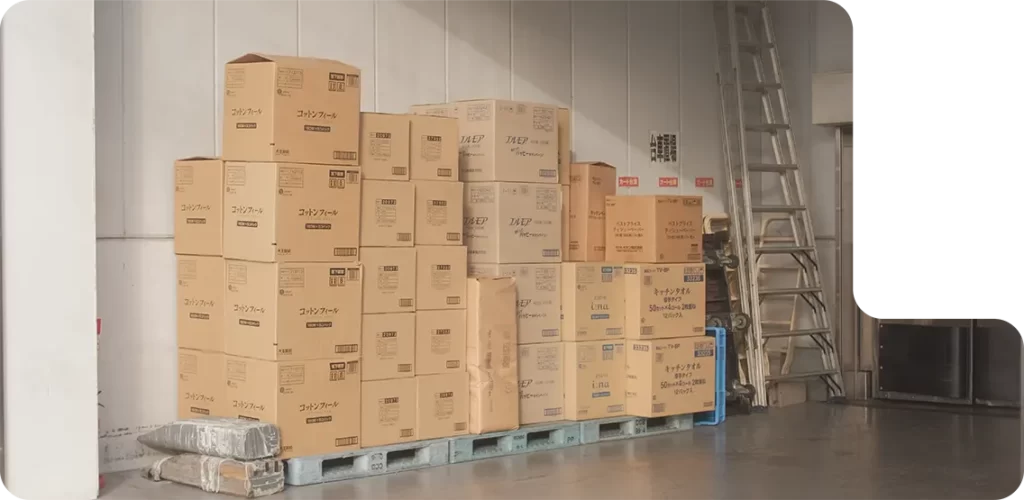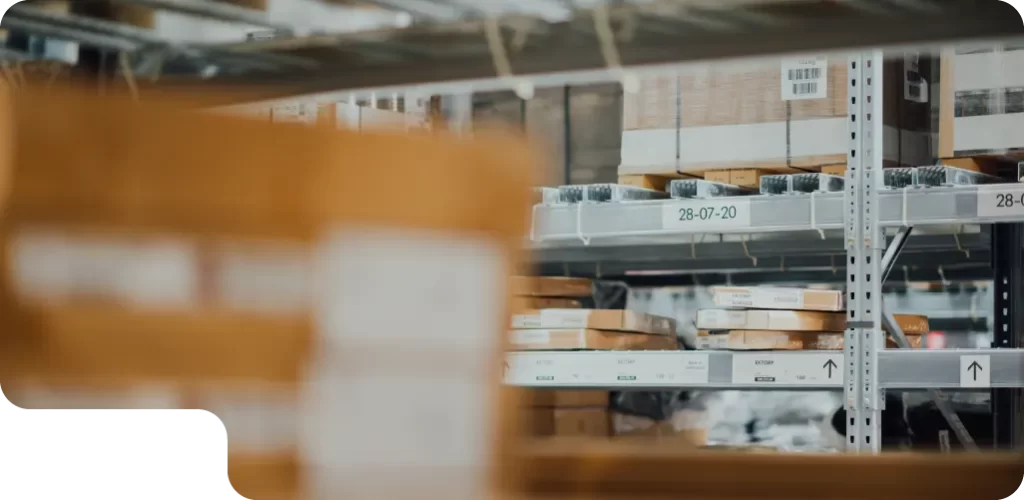Table of Contents
More Inventory Content
Get the latest e-commerce industry news, best practices, and product updates!
Table of Contents
More Inventory Content
Share This
Get the latest e-commerce industry news, best practices, and product updates!
Table of Contents
Share This
More Inventory Content
Get the latest e-commerce industry news, best practices, and product updates!
The inventory is a valuable asset for a company’s balance sheet irrespective of the business size and type. Inventory is a useful accounting tool applicable in each manufacturing stage as the bridge between production and order processing. This critical income-generating source is crucial to a company’s commercial activities and directly impacts the company’s fulfillment performance.
Manufacturers’ inventory produces the inventory, whereas merchandise inventory focuses on buying the finished goods. A company’s ability to understand and optimize its merchandise inventory directly impacts its overall profitability, competitiveness, efficiency, and ultimately, customer satisfaction.
What is Merchandise Inventory?
The goods intended for sale acquired by wholesalers, retailers, and distributors from the suppliers and manufacturers, capsules the term merchandise inventory. Merchandise inventory can constitute finished goods or raw materials ready to sell that are designed for resale to customers.
Merchandise inventory is a current asset that records the procurement value before being sold as of the balance sheet date. The value of merchandise inventory includes the total price paid to suppliers for the finished goods/raw materials and the associated costs like insurance, transportation, and storage.
Importance of Merchandise Inventory
A merchandise inventory is an online business’s most prominent current asset, contributing directly to the company’s well-being. The firm needs to understand the process of merchandising inventory for accurate calculations related to overall expenses, assets, and profitability. In addition, the knowledge required for precise calculations helps a company understand the critical related financial aspects, including
Prevents Understocking Of Inventory
Running short of inventory levels can be a critical error for most businesses. Understocking leads to a direct loss in business sales and lowers customers’ loyalty to your brands. Furthermore, the inability to fulfill your customers due to the unavailability of stock gives your business a straight ticket to losing its positive brand image.
Inventory
The physical products stored for sale and resell purposes by a business
Balance Sheet
The financial statement with operational transactions, including expenses, revenue, and profit margins
Market Value
Determining the ideal value of a finished good for selling on the open market
Expenses
The financial transactions, including payments and financial obligations taken by a firm for day-to-day operations.
Total Cost Of Goods Sold
A company’s price to produce its inventory and sell the items for the cost of goods sold is reflected as an expense on the balance sheet.
Current Asset
A company’s physical inventory accounts for current and other liquidated assets on the balance sheet.
Periodic Inventory
The inventory information is updated periodically as and when required by the business.
Perpetual Inventory
The method of merchandising inventory and updating the information regularly.

Accounting for Merchandise Inventory
Merchandise inventory accounting uses different inventory valuation methods per specific needs and requirements. Inventory turnover and control management must follow the Generally Accepted Accounting Principles (GAAP) rules. It requires all inventory to be adequately accounted for using either the cost or market value method, using the inventory as an asset to rule out depreciation. A firm must adhere to a specific plan for inventory accounting for accurate, consistent, and, most notably, legally acceptable financial documents.
The standard inventory valuation methods used are:
First In First Out (FIFO)
FIFO is used not only in handling stock in a warehouse but also as a method of valuing unsold merchandise inventory. It follows the principle that purchased inventory must be sold first. The products received and sold in a merchandise inventory are recorded individually in this FIFO accounting method. However, there’s a possibility of underestimating or overestimating the inventory’s value due to the future ever-changing market pattern.
Last In First Out (LIFO)
The LIFO method assumes that the most recent products added to the merchandise inventory will be sold first. LIFO works best for businesses specializing in non-perishable items. It can also increase COGS and diminish the gross profit margins due to the cost difference in the products’ recent and old market prices.
Weighted Average Accounting Method
Average Cost Inventory Accounting method is primarily based on the average cost of items throughout an accounting period of a company. It is different from the above two methods and does not track the price per inventory unit for each separate purchase or delivery. The weighted average can be derived by simply dividing the overall cost of products in the merchandise inventory available for sale by the total inventory available.
Specific Identification Method
The specific identification method tracks every item in the merchandise inventory from purchase to sale. The technique works best for merchandise inventory comprising large, easily identifiable items with different features and costs. However, the approach requires the companies to track individual items with an RFID tag, the specific ID attached to things that provide the most accurate inventory cost and profit record.
Although the specific identification method imparts a high degree of accuracy to the inventory valuation process, it is broadly restricted to valuing rare and high-value items such as vehicles, precious jewels, and real estate.

Merchandising Inventory Methods
Merchandise inventory is measured by either traditional methods: a periodic inventory method or a perpetual inventory system.
Perpetual Merchandising Inventory System
As part of the perpetual merchandising inventory procedure, companies must continuously update the information on the inventory being sold. The regular financial reports update allows the business to study the inventory operations and the transactions during the accounting period. The transactions made during the period include:
- Purchases recorded as debits to the inventory and credits to the payable accounts
- Sales recorded as debits to the cost of goods sold
- Total credits to the inventory accounts
- Adjustments in the debited quantity recorded to the cost of goods sold and inventory account credits
- Inventory location transitions

The perpetual merchandising inventory method is the most common procedure taken up by the companies to track all aspects of merchandising inventory in real-time.
Periodic Merchandising Inventory System
Periodic merchandising inventory doesn’t require companies to maintain an ongoing update of the inventory value and quantity. In periodic inventory, a business takes an inventory report at specific intervals to determine the changes in merchandising inventory. The process includes manually accounting and comparing the inventory at specific accounting cycles.
Businesses using periodic inventory include
- Small enterprises that possess the ability to account for their inventory in the stipulated time cycle manually.
- Businesses that don’t have the resources for inventory automation technology and software
- Businesses selling lower-value products in a very high volume like hardware stores selling nuts, bolts, nails, and screws or a sweet shop selling thousands of candies. Apparently, perpetual merchandising inventory tracking for such small inventory is unnecessary for small businesses where the inventory loses some value with the subsequent transactions.
Periodic merchandising inventory methods tend to be inaccurate and prone to human error. Therefore this inventory method fails to provide any real-time insights into the cost of goods sold, turnover ratio, and other inventory metrics for the business.

Effective Measures for Efficient Merchandise Inventory Performance
Merchandise inventory tends to deal with retail-oriented businesses and is primarily warehouse oriented. The ways the merchandise inventory can be made more effective are:
First In First Out
The First-In, First-Out (FIFO) method is an effective way to keep the merchandise inventory fresh and the profits high. By selling the items that are acquired first before those that have been acquired later, the business can ensure that the shipments are of the highest quality. Effective while selling seasonal products, FIFO allows a company to calculate the value of the remaining stock based on the cost of goods sold from the first product acquired, using the original price to value the inventory. This ensures that the profits stay consistent, regardless of market fluctuations. FIFO helps the business to run smoothly and profitably.

Last In First Out
Last-In, First-Out (LIFO) method allows the businesses seeking to sell the inventory that was acquired last, first. This helps in adjusting the accounting of the merchandise inventory asset to reflect the price of the inventory acquired first. This is effective for businesses that sell non-perishable goods to maintain high-quality shipments.
Just-In-Time (JIT)
Just in Time is a method where inventory is only purchased as needed, rather than being kept in stock. This can be effective for businesses with fluctuating sales, as it prevents them from being stuck with excess inventory. This method reduces risk, overhead cost of storage and unnecessary wastage from unused merchandise inventory.
ABC Analysis
ABC Analysis helps a business prioritize the sale of different products based on the cost of goods sold (COGS). This method divides the merchandise inventory into three distinctive groups:
A – High-value, low sales: Consists of the merchandise inventory, making good money but costs a significant amount to procure. Keeping this group for too long can cause financial strain.
B – middle-value, average sales: Consists of goods that aren’t sold frequently and have a predictable base.
C – low-value, high sales: Consists of the high sold items in the merchandise inventory, providing a boost to the balance sheet without much profit margins.
According to the division, a company can focus on the products that help in providing value to the financial reports and maintain consistency in sales and inventory changes. ABC Analysis is the best method for a merchandise inventory to boost its performance effectively.

How to Calculate Merchandise Inventory
Merchandise inventory calculation uses some specific fields from the company’s income statement that include:
- Beginning Inventory
- Cost of Goods Sold (COGS)
- Ending Inventory
Beginning Merchandise Inventory Calculation
The beginning merchandise inventory or opening merchandise inventory is the value of the inventory at the start of the accounting period. The opening merchandise inventory value is calculated before any inventory procurement or selling of any existing inventory. The beginning inventory of the present accounting cycle includes the ending merchandise inventory value from the previous accounting cycle.
Beginning Merchandise Inventory = (Ending Inventory + COGS) - Inventory Purchased

Cost Of Goods Sold (COGS) Calculation
Cost of goods sold calculates the total amount associated with the production, like labor, raw materials, etc., of the final products in merchandise inventory. COGS is the primary mode of valuation to determine the number of gross profits made in a single or multiple sales.
Cost Of Goods Sold = (Beginning Inventory Cost + Purchases Cost) - Ending Inventory
Merchandise Inventory Calculation
Merchandise inventory is considered the ‘ending inventory’ as it is the final amount to be reported on the balance sheet for the stipulated accounting period. Merchandise inventory is calculated by adding a new inventory amount to the beginning inventory and subtracting the cost of goods sold (COGS).
Ending Merchandise Inventory = (Beginning Inventory + New Inventory) - COGS

How to Calculate Merchandise Inventory
Finished goods inventory consists of the goods that have been completed by the manufacturing process or are purchased in a complete form yet to be sold to the customers. While merchandise inventory refers to the finished goods inventory procured by a business from the manufacturing units or suppliers that are ready to sell.
What Is Merchandise On Hand?
Merchandise on hand refers to the cost of goods available for sale at any time in the inventory. It is the part of merchandise inventory that doesn’t include the cost of goods or inventory shrinkage. Merchandise on hand has finished goods inventory, goods held on consignment, and safety stock.
Is Merchandise Inventory an Asset?
An asset in e-commerce refers to things and resources owned by a company or an individual with monetary value. Assets owned by a firm impart enormous economic value, facilitate daily operations, and help determine the company’s monetary value. Inventories are considered an asset for the company and include finished goods and merchandise that a firm usually procures for sale and resale.
Merchandise inventory is usually purchased to sell its components in a stipulated accounting period or a fiscal year. Therefore, merchandise inventory is classified as an asset for the company. The leftover inventory at the end of an accounting period or fiscal year is reported as ‘ending inventory’ on the company’s balance sheet. However, the cost of goods sold (COGS) is considered an expense on the income statement per fiscal year.

Is Merchandise Inventory a Current or Non-current Asset?
Typically there are two types of assets in an e-commerce business:
Current Assets – The assets in a firm that are reasonably expected to be converted into cash within one fiscal year.
Non-current Assets – Assets including long-term investments, intangible assets like technological, intellectual property, physical properties like houses, buildings, etc., that take a long time to liquidate.
As merchandise inventory is procured for bringing economic benefits to the company in a given fiscal year or accounting period, it is considered a current asset. Merchandise inventory is usually liquidated within the stipulated accounting period or a year of being acquired.

What Type of Account Is Merchandise Inventory
Merchandise inventory accounts for all products procured by a company intended for sale and resale. The products of merchandise inventory typically follow the usual supply chain process from merchandise suppliers to storage facilities to inventory.
Merchandise inventory is the account on a company’s balance sheet that reflects the total cost of the products and the cost of the products that are yet to be sold. It is a holding account for a company’s inventory with a normal debit balance. Any purchases for merchandise inventory are recorded as a debit to the inventory account and a credit to accounts payable.

Merchandise Inventory on Income Statements
Although merchandise inventory is classified as a current asset on the company’s balance sheet, it is not an income statement account. However, merchandise inventory information is vital for calculating the Cost of Goods Sold (COGS), which is reflected on the income statement. Any change in the merchandise inventory leads to a change in the COGS for a firm. The information needed from the merchandise inventory to calculate COGS is
- Opening Stock – The cost of the goods in the inventory at the beginning of the accounting period
- The total cost of purchases in the inventory during the accounting period.
- Closing Stock – The cost of goods for closing inventory at the end of the accounting period.
The cost of any merchandise inventory sold during the stipulated accounting period is reported as expenditure on the income statement of that particular accounting period. However, the merchandise inventory not sold during the accounting period is registered as current assets. It is included in the balance sheet for the next accounting period for the time being until it is sold.
Conclusion
Merchandise inventory is the inventory of goods that a company procures to resell to customers. Typically retailers and wholesalers are the businesses
to use merchandise inventory. Efficient tracking and managing of merchandise inventory are crucial for a company’s financial health. Therefore,
a business must understand and optimize its merchandise inventory to decrease expenses, increase performance and profitability, and improve customer
satisfaction and loyalty.
Sign up today and LEAVE THE LOGISTICS TO US
Sign up, and we will get back to you within 24 hours to discuss what services would be best for your business needs. Or speak with us now and tell us what you need.
FAQs
Merchandise inventory is any kind of product and materials a company has on hand that is intended for sale. The term merchandise inventory consists of the value of goods, including raw materials or finished goods, that are ready to be sold to customers, including raw materials or finished goods.
Merchandise inventory is usually recorded as a prepaid expense on a company’s balance sheet. It is considered a prepaid expense as the inventory has already been procured for reselling. When merchandise inventory is sold, it is shifted from the asset category to the expense category. This is because any product sold first must be created or purchased, which always incurs an expense.
Quick assets, sometimes referred to as current assets, are only those assets that can be quickly converted to cash. Merchandise inventory isn’t considered a quick asset because it can’t rapidly be converted to cash. To hold a quick asset, a company must sell inventory immediately and receive payment on the spot, which is often impossible.
Two primary methods of calculating merchandise inventory are:
- Perpetual Merchandising Inventory – Perpetual inventory system helps a company automatically record product sales and update its merchandise inventory in real-time.
- Periodic Merchandising Inventory – This method relies on a manual inventory accounting process performed at the end of an accounting period. This method doesn’t provide real-time tracking and is prone to human errors.
Merchandising inventory tracking is crucial for businesses to accurately calculate their assets, expenses, and overall profitability. Merchandise inventory is one of the significant current assets recorded on a balance sheet. The cost of the merchandise sold is recorded as COGS on the company’s income statement. COGS is further used to calculate the gross and net profit.